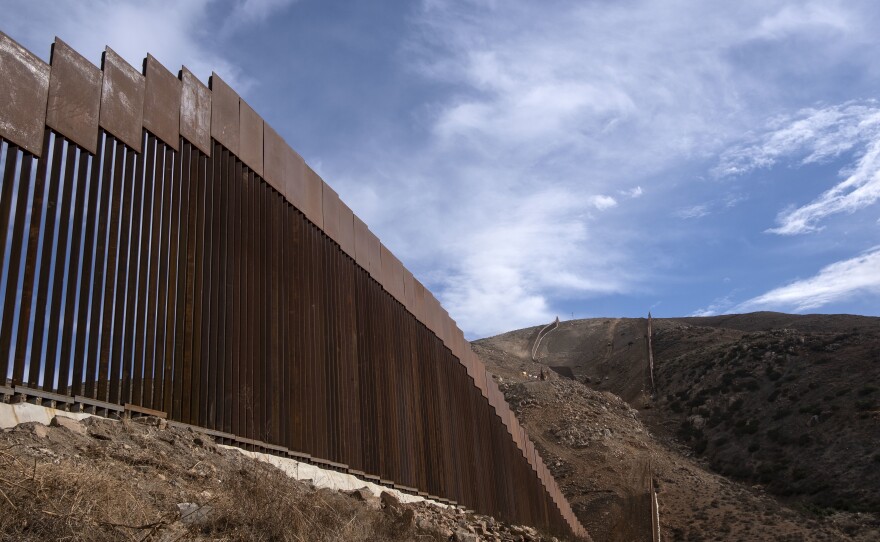The bulldozers, excavators, concrete trucks and water haulers are parked. The construction crews are gone. And hundreds of 30-foot-tall steel panels are stacked up and down the U.S.-Mexico border.
As promised, President Biden has halted construction of the massive wall — former President Donald Trump's signature project. The new administration has called for a two-month suspension while border security officials sort out what to do next.
"We're cautiously optimistic, and we're definitely celebrating. We all raised a glass of mescal the night the order was issued!" said Laiken Jordahl, with the Center for Biological Diversity in Tucson.
"We've been fighting this project for years, and this is the first time we've been able to take a step back and have a deep sigh of relief," he added.
While wall opponents in the borderlands are celebrating, they also say the fight may be moving into a new phase.
Activists say environmentally sensitive areas that have been bulldozed and wildlife corridors that have been closed off must be restored. Some oppose other kinds of security measures the Biden administration may impose, such as a patrol road and surveillance cameras, that they say would "militarize" the border.
The Biden administration has not revealed the fate of the border wall — one of the biggest federal construction projects in U.S. history. During the 60-day pause, White House officials say they plan to study how to "redirect funding and repurpose contracts."
Contractors were able to put up 453 miles of wall over the past four years. Nearly 300 more miles of wall have been contracted but remain unfinished.
The government reportedly could save about $2.6 billion if construction doesn't resume. But terminating contracts early also means paying tens of millions in cancellation fees.
Biden's Homeland Security Department and the U.S. Army Corps of Engineers confirmed to NPR that every wall construction project has been suspended from San Diego to the Rio Grande Valley — the executive order Biden signed the day he took office gave officials seven days to do so. When asked about next steps, DHS referred NPR to the White House.
According to Rep. Henry Cuellar, a Laredo Democrat, DHS is willing to cancel the wall but continue other planned security installations. He has nearly 200 border miles in his district and says he was in touch with the department last week.
"I don't like the wall. But we've got to use other things — cameras, technology, drones and all that," Cuellar said. "I understand some people don't want anything. They don't want cameras, they don't want lights, they don't want underground sensors. And I'm sorry, but we have a responsibility to secure the border."
Working 24/7 — racing the clock until Inauguration Day — crews had been dynamiting mountainsides in Arizona to make way for sections of wall that would likely never get built.
Contractors have fenced off more than half of Arizona's border with Mexico in the environmentally sensitive Sonoran Desert.
Gary Nabhan, a longtime ecologist and writer in Southern Arizona, says in just one protected wilderness, Organ Pipe Cactus National Monument, the wall blocked 52 wildlife corridors where animals are known to cross in search of food and water.
For activists like Nabhan, their energies now turn to restoration.
They're calling on the administration "to take down the wall in the critical corridors for wildlife that are usually watered places rivers and oases," Nabhan said. "It's going to take a herculean effort to undo the damage."
Most landowners on the Rio Grande never wanted a giant security fence to begin with. Property owners opposed to the wall have long maintained that Customs and Border Protection, which is part of DHS, could substitute technology for steel and concrete.
Beto Cardenas, a lawyer for Sacred Heart Children's Home, an orphanage in Laredo whose property was in the path of the barrier, said, "Obviously, given the fact that there's been a pause, we would hope that the Biden administration would see that there isn't a need for a physical barrier."
Cardenas, who has worked on Capitol Hill as an immigration expert, says unspent funds may be redirected to a different kind of border security, such as hi-tech autonomous surveillance towers.
"I would expect that there would be an investment in all sorts of other personnel, infrastructure and technology, the measures necessary to protect the southwestern border," Cardenas said.
But even that would run into opposition from activists like Tricia Cortez, with the No Border Wall coalition in Laredo.
"We don't want the direction to move from a physical wall to a virtual wall and continue down this path of militarizing the border," she said.
Copyright 2021 NPR. To see more, visit https://www.npr.org.






